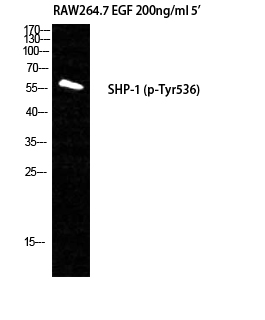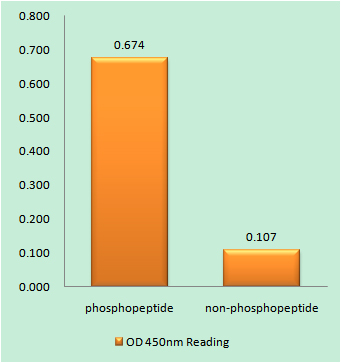
Catalog: KA1180C
Size
Price
Status
Qty.
96well
$470.00
In stock
0
Add to cart


Collected


Collect
Main Information
Reactivity
Human, Mouse, Rat
Applications
ELISA
Conjugate/Modification
Phospho
Detailed Information
Storage
2-8°C/6 months,Ship by ice bag
Modification
Phospho
Detection Method
Colorimetric
Related Products
Antigen&Target Information
Gene Name:
PTPN6
show all
Other Name:
Tyrosine-protein phosphatase non-receptor type 6 ;
Hematopoietic cell protein-tyrosine phosphatase ;
Protein-tyrosine phosphatase 1C ;
PTP-1C ;
Protein-tyrosine phosphatase SHP-1 ;
SH-PTP1 ;
Hematopoietic cell protein-tyrosine phosphatase ;
Protein-tyrosine phosphatase 1C ;
PTP-1C ;
Protein-tyrosine phosphatase SHP-1 ;
SH-PTP1 ;
show all
Background:
catalytic activity:Protein tyrosine phosphate + H(2)O = protein tyrosine + phosphate.,function:Plays a key role in hematopoiesis. This PTPase activity may directly link growth factor receptors and other signaling proteins through protein-tyrosine phosphorylation. The SH2 regions may interact with other cellular components to modulate its own phosphatase activity against interacting substrates. Together with MTUS1, induces UBE2V2 expression upon angiotensin II stimulation.,PTM:Phosphorylated on serine and tyrosine residues.,similarity:Belongs to the protein-tyrosine phosphatase family. Non-receptor class 2 subfamily.,similarity:Contains 1 tyrosine-protein phosphatase domain.,similarity:Contains 2 SH2 domains.,subcellular location:In neurons, translocates into the nucleus after treatment with angiotensin II.,subunit:Monomer. Interacts with MTUS1 (By similarity). Binds PTPNS1, LILRB1 and LILRB2. Interacts with FCRL2, FCRL3, FCRL4, CD300LF and CD84.,tissue specificity:Isoform 1 is expressed in hematopoietic cells while isoform 2 is expressed in non-hematopoietic cells.,
show all
Function:
protein amino acid dephosphorylation, phosphorus metabolic process, phosphate metabolic process, apoptosis, cell surface receptor linked signal transduction, G-protein coupled receptor protein signaling pathway, cell death, negative regulation of cell proliferation, response to wounding, programmed cell death, death, dephosphorylation, regulation of cell proliferation,
show all
Cellular Localization:
Cytoplasm. Nucleus. In neurons, translocates into the nucleus after treatment with angiotensin II (By similarity). Shuttles between the cytoplasm and nucleus via its association with PDPK1. .
show all
Tissue Expression:
Signaling Pathway
Cellular Processes >> Cellular community - eukaryotes >> Adherens junction
Organismal Systems >> Immune system >> Natural killer cell mediated cytotoxicity
Organismal Systems >> Immune system >> T cell receptor signaling pathway
Organismal Systems >> Immune system >> B cell receptor signaling pathway
Human Diseases >> Cancer: overview >> PD-L1 expression and PD-1 checkpoint pathway in cancer
Environmental Information Processing >> Signal transduction >> JAK-STAT signaling pathway
Reference Citation({{totalcount}})
Catalog: KA1180C
Size
Price
Status
Qty.
96well
$470.00
In stock
0
Add to cart


Collected


Collect
Recently Viewed Products
Clear allPRODUCTS
CUSTOMIZED
ABOUT US
Toggle night Mode
{{pinfoXq.title || ''}}
Catalog: {{pinfoXq.catalog || ''}}
Filter:
All
{{item.name}}
{{pinfo.title}}
-{{pinfo.catalog}}
Main Information
Target
{{pinfo.target}}
Reactivity
{{pinfo.react}}
Applications
{{pinfo.applicat}}
Conjugate/Modification
{{pinfo.coupling}}/{{pinfo.modific}}
MW (kDa)
{{pinfo.mwcalc}}
Host Species
{{pinfo.hostspec}}
Isotype
{{pinfo.isotype}}
Product {{index}}/{{pcount}}
Prev
Next
{{pvTitle}}
Scroll wheel zooms the picture
{{pvDescr}}


















